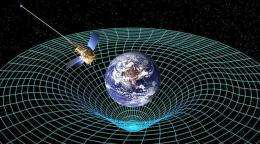December 16, 2009 feature
Proposed Spacetime Structure Could Provide Hints for Quantum Gravity Theory

(PhysOrg.com) -- Spacetime, which consists of three dimensions of space and one time dimension, is such a large, abstract concept that scientists have a very difficult time understanding and defining it. Moreover, different theories offer different, contradictory insights on spacetime’s structure. While general relativity describes spacetime as a continuous manifold, quantum field theories require spacetime to be made of discrete points. Unifying these two theories into one theory of quantum gravity is currently one of the biggest unsolved problems in physics.
In an attempt to better understand spacetime, mathematical physicist Achim Kempf of the University of Waterloo has proposed a new possible structure of spacetime on the Planck scale. He suggests that spacetime could be both discrete and continuous at the same time, conceivably satisfying general relativity and quantum field theories simultaneously. Kempf’s proposal is inspired by information theory, since information can also be simultaneously discrete and continuous. His study is published in a recent issue of Physical Review Letters.
“There are fiercely competing schools of thought, each with good arguments, about whether spacetime is fundamentally discrete (as, for example, in spin foam models) or continuous (as, for example, in string theory),” Kempf told PhysOrg.com. “The new information-theoretic approach could enable one to build conceptual as well as mathematical bridges between these two schools of thought.”
As Kempf explains, the underlying mathematical structure of information theory in this framework is sampling theory - that is, samples taken at a generic discrete set of points can be used to reconstruct the shape of the information (or spacetime) everywhere down to a specific cutoff point. In the case of spacetime, that cutoff would be the natural ultraviolet lower bound, if it exists. This lower bound can also be thought of as a minimum length uncertainty principle, beyond which structural properties cannot be precisely known.
In his study, Kempf develops a sampling theory that can be generalized to apply to spacetime. He shows that a finite density of sample points obtained throughout spacetime’s structure can provide scientists with the shape of spacetime from large length scales all the way down to the natural ultraviolet cutoff. Further, he shows that this expression establishes an equivalence between discrete and continuous representations of spacetimes. As such, the new framework for the sampling and reconstruction of spacetime could be used in various approaches to quantum gravity by giving discrete structures a continuous representation.
“It is exceedingly hard to obtain experimental data that could guide the search for the theory that unifies quantum theory and general relativity,” Kempf said. “The proposal that spacetime is simultaneously continuous and discrete in the same way that information is may be able to serve as a theoretical guiding principle. It points towards a theory in which all natural processes are seen as possessing what is in effect a universal finite bandwidth.”
Kempf added that, at the very least, the new approach provides some practical technical tools for studies in quantum gravity, such as solving discrete problems and using continuum methods. In the future, Kempf plans to apply the new methods to a variety of problems.
“I am planning to use the new information-theoretic methods to tackle afresh certain long-standing information-theoretic questions in quantum gravity, such as the black hole information loss paradox and the question of the role of the holographic principle in quantum field theory,” Kempf said.
More information: Achim Kempf. “Information-Theoretic Natural Ultraviolet Cutoff for Spacetime.” Physical Review Letters 103, 231301 (2009).
Copyright 2009 PhysOrg.com.
All rights reserved. This material may not be published, broadcast, rewritten or redistributed in whole or part without the express written permission of PhysOrg.com.


















